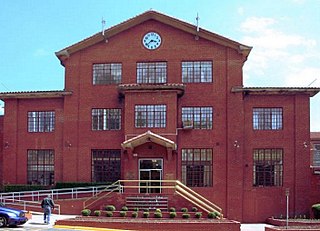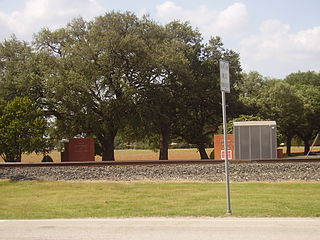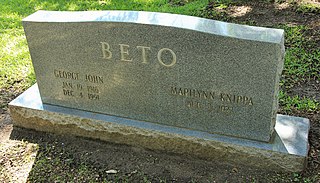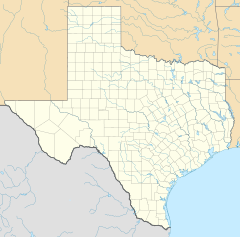
Capital punishment is a legal penalty in the U.S. state of Texas for murder, and participation in a felony resulting in death if committed by an individual who has attained or is over the age of 18.

Texas State Penitentiary at Huntsville or Huntsville Unit (HV), nicknamed "Walls Unit", is a Texas state prison located in Huntsville, Texas, United States. The approximately 54.36-acre (22.00 ha) facility, near downtown Huntsville, is operated by the Correctional Institutions Division of the Texas Department of Criminal Justice. The facility, the oldest Texas state prison, opened in 1849.

Lovelady Independent School District is a public school district based in Lovelady, Texas (USA), located within Houston County.

The Texas Department of Criminal Justice (TDCJ) is a department of the government of the U.S. state of Texas. The TDCJ is responsible for statewide criminal justice for adult offenders, including managing offenders in state prisons, state jails, and private correctional facilities, funding and certain oversight of community supervision, and supervision of offenders released from prison on parole or mandatory supervision. The TDCJ operates the largest prison system in the United States.

Allan B. Polunsky Unit is a prison in West Livingston, unincorporated Polk County, Texas, United States, located approximately 5 miles (8.0 km) southwest of Livingston along Farm to Market Road 350. The Texas Department of Criminal Justice (TDCJ) operates the facility. The unit houses the State of Texas death row for men, and it has a maximum capacity of 2,900. Livingston Municipal Airport is located on the other side of FM 350. The unit, along the Big Thicket, is 60 miles (97 km) east of Huntsville.

O. B. Ellis Unit is a Texas Department of Criminal Justice prison located in unincorporated Walker County, Texas, 12 miles (19 km) north of Huntsville. The unit, with about 11,427 acres (4,624 ha) of space, now houses up to 2,400 male prisoners. Ellis is situated in a wooded area shared with the Estelle Unit, which is located 3 miles (4.8 km) away from Ellis. From 1965 to 1999 it was the location of the State of Texas men's death row.
Ruiz v. Estelle, 503 F. Supp. 1265, filed in United States District Court for the Southern District of Texas, eventually became the most far-reaching lawsuit on the conditions of prison incarceration in American history.

The John M. Wynne Unit (WY) is a men's prison of the Texas Department of Criminal Justice, located in northern Huntsville, Texas, at the intersection of Farm to Market Road 2821 West and Texas State Highway 75 North. The Windham School District has its headquarters in the unit. Wynne, the second oldest prison in Texas, was named after John Magruder Wynne, who served as a prison employee and later as a board member of the prison system from 1878 to 1881. The unit, on a 1,412 acres (571 ha) plot of land, is co-located with the Holliday Unit.

The Central Unit was a Texas Department of Criminal Justice (TDCJ) men's prison in Sugar Land, Texas. The approximately 325.8-acre (131.8 ha) facility is 2 miles (3.2 km) from the central part of the city of Sugar Land on U.S. Highway 90A.

The Retrieve Unit, later the Wayne Scott Unit, was a Texas Department of Criminal Justice (TDCJ) prison farm located in unincorporated Brazoria County, Texas. The unit, southwest of Houston, is along County Road 290, 8 miles (13 km) south of Angleton. Scott, which was established in September 1919, has about 5,766 acres (2,333 ha) of land.

The Christina Melton Crain Unit is a Texas Department of Criminal Justice prison for females in Gatesville, Texas. The prison is along Texas State Highway 36, 3 miles (4.8 km) north of central Gatesville. The unit, with about 1,317 acres (533 ha) of space, is co-located with the Hilltop Unit, the Dr. Lane Murray Unit, and the Linda Woodman Unit. Nearby also is the Mountain View Unit, which houses all Texas female inmates on death row. Crain Unit's regular program houses around 1,500 women, and it is one of Texas's main prisons for women. Female prison offenders of the TDCJ are released from this unit. With a capacity of 2,013 inmates, Crain is the TDCJ's largest female prison.

The Thomas Goree Unit (GR) is a Texas Department of Criminal Justice men's prison, located in Huntsville, Texas, 4 miles (6.4 km) south of downtown Huntsville on Texas State Highway 75 South. The Goree Unit is located within Region I. First opened in 1911, it served as the only women's correctional facility in Texas until 1982, after the women were moved to state prisons in Gatesville. For a period Goree held the state's sole female death row inmate, until her conviction was changed to a non-capital offense. There was more than one death row female at Goree in 1979.

The W. F. Ramsey Unit is a Texas Department of Criminal Justice prison farm located in unincorporated Brazoria County, Texas, with a Rosharon postal address; it is not inside the Rosharon census-designated place. The prison is located on Farm to Market Road 655, 4 miles (6.4 km) west of Farm to Market Road 521, and south of Houston. The 16,369-acre (6,624 ha) unit is co-located with the Stringfellow Unit and the Terrell Unit.

The Gatesville State School for Boys was a juvenile corrections facility in Gatesville, Texas. The 900-acre (360 ha) facility was converted into two prisons for adults, the Christina Crain Unit, and the Hilltop Unit.

The Mark W. Michael Unit (MI) is a Texas Department of Criminal Justice men's prison located in unincorporated Anderson County, Texas. The unit is along Farm to Market Road 2054, 4 miles (6.4 km) south of Tennessee Colony. The unit, on 20,518 acres (8,303 ha) of land, is co-located with the Beto, Coffield, and Powledge prison units and the Gurney Transfer Unit. The unit is in proximity to Palestine and the Rusk ironworks, and it is in about a one-hour driving distance from Dallas.

The Holliday Transfer Facility, is a Texas Department of Criminal Justice transfer facility for men located in Huntsville, Texas. Holliday is along Interstate 45 and .5 miles (0.80 km) north of Texas State Highway 30. The unit, on a 1,412-acre (571 ha) plot of land, is co-located with the Wynne Unit.

George John Beto was a director of the Texas Department of Corrections (TDC), a criminal justice expert in penology, a professor, and a Lutheran minister. He was previously the president of Concordia Lutheran College in Austin and Concordia Theological Seminary in Springfield, Illinois.
The Texas Prison Rodeo was a rodeo and an annual celebration event for inmates in the Texas Prison System, held in a stadium in Huntsville, Texas. The stadium was located at the Huntsville Unit. The events included bareback basketball, bronco riding, bull riding, calf roping, and wild cow milking.
The Wallace Pack Unit (P1) is a Texas Department of Criminal Justice (TDCJ) prison in unincorporated Grimes County, Texas, 5 miles (8.0 km) south of Navasota. It is along Farm to Market Road 1227, in proximity to Houston.
Texas Tough: The Rise of America's Prison Empire is a 2010 book by Robert Perkinson, published by Metropolitan Books.
















